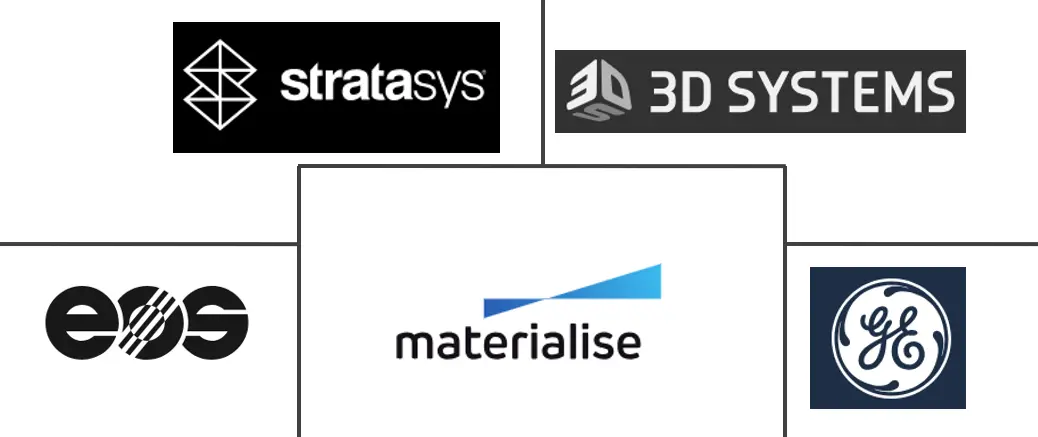3D Printing Materials Market Size and Share
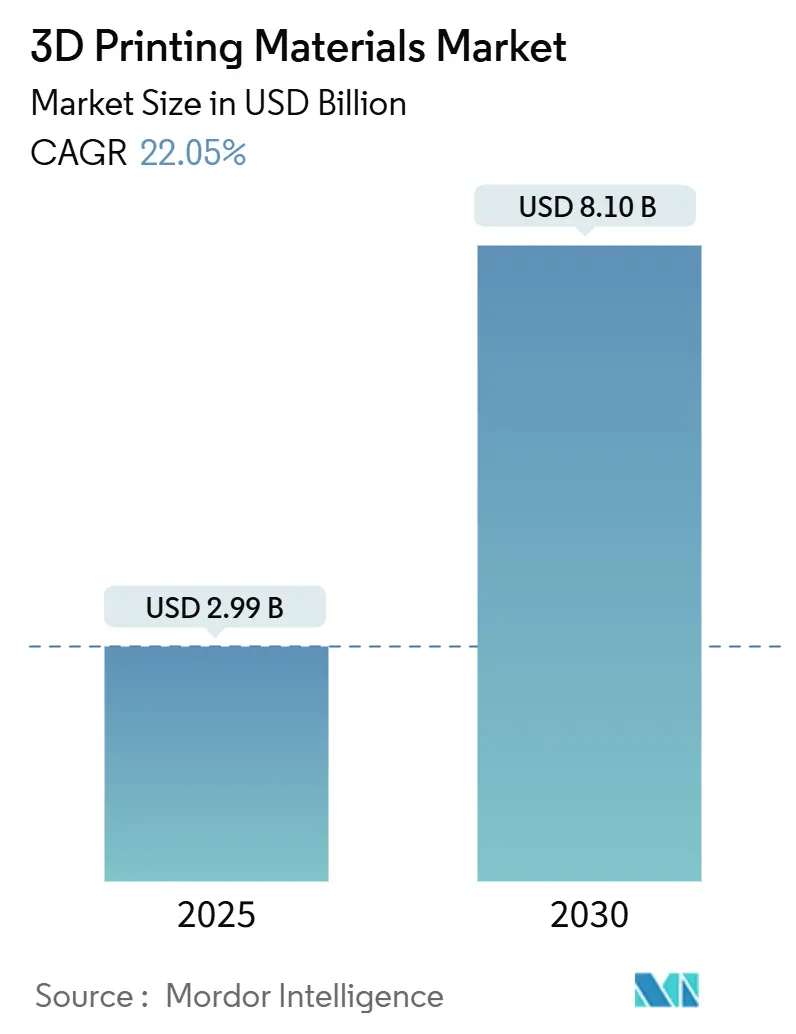
3D Printing Materials Market Analysis by Mordor Intelligence
The 3D printing materials market reached USD 2.99 billion in 2025 and is forecast to rise to USD 8.10 billion by 2030, advancing at a 22.05% CAGR. This expansion reflects the migration of additive manufacturing from a prototyping resource to a validated production tool across aerospace, automotive, and healthcare supply chains. Aerospace primes continue to qualify titanium, nickel, and aluminum powders for serial production, while medical device makers secure regulatory clearances for patient-specific polymers and metals. Automotive OEMs accelerate adoption of lightweight electric-vehicle components and tooling efficiencies. Rapid material innovation lowers cycle times, improves part performance, and opens new revenue streams for chemical companies and printer vendors. Competitive strategies now center on tight integrating hardware, software, and consumables to lock in repeat material revenue.
Key Report Takeaways
- By material type, plastics retained 47.25% of the 3D printing materials market share in 2024; metals are projected to record the fastest 23.24% CAGR to 2030.
- By form, filament captured 68.42% revenue share of the 3D printing materials market in 2024 and is expected to expand at a 23.51% CAGR through 2030.
- By end-user industry, aerospace and defense accounted for 36.28% share of the 3D printing materials market size in 2024, while automotive is anticipated to grow at 24.87% CAGR between 2025-2030.
- By geography, North America led with a 39.46% share in 2024; Asia-Pacific is set to deliver the highest 26.25% CAGR to 2030.
Global 3D Printing Materials Market Trends and Insights
Driver Impact Analysis
| Driver | (~) % Impact on CAGR Forecast | Geographic Relevance | Impact Timeline |
|---|---|---|---|
| Surge in metal powder usage for serial aerospace and medical production | +4.2% | Global, early gains in North America and Europe | Medium term (2-4 years) |
| Rapid advances in high-performance polymers | +3.8% | Global | Short term (≤ 2 years) |
| Surge in demand from automotive applications | +3.5% | Asia-Pacific core; spill-over to North America | Medium term (2-4 years) |
| Mass-customization momentum in healthcare and consumer goods | +2.9% | North America and EU, expanding to Asia-Pacific | Long term (≥ 4 years) |
| Increase in the adoption of bio-based/biodegradable feedstocks | +2.1% | Global regulatory push in Europe | Long term (≥ 4 years) |
| Source: Mordor Intelligence | |||
Surge in Metal Powder Usage for Serial Aerospace and Medical Production
Aerospace OEMs have moved beyond demonstration projects to certify titanium, nickel, and aluminum alloys for flight-critical components, with Ti-6Al-4V representing the major portion of the aerospace powder consumption thanks to its high strength-to-weight ratio and corrosion resistance. Medical device firms mirror this shift; biocompatible titanium and cobalt-chrome powders now support cranial plates, spinal cages, and joint replacements with internal lattices unachievable through subtractive routes. Honeywell’s 2025 qualification of 6K Additive Nickel 718 illustrates how recycled feedstock can meet stringent turbine-engine requirements while reducing raw-material waste. Lengthy two-year qualification regimes create high entry barriers and shield incumbent powder suppliers from price-based disruption, reinforcing consolidation trends.
Rapid Advances in High-Performance Polymers
Polyetheretherketone (PEEK), polyetherketoneketone (PEKK), and carbon-fiber-reinforced blends are replacing aluminum in satellite brackets, orthopedic trauma plates, and oil-and-gas flow restrictors. Stratasys introduced VICTREX AM 200 in 2025, enabling hundreds of parts per build and maintaining dimensional accuracy at 150 °C service temperatures. Dual-nozzle fused deposition systems now embed continuous carbon rovings that lift in-plane thermal conductivity to 4.54 W/(m·K), expanding use cases in heat sinks and EMI shielding[1]“Thermally conductive carbon-fiber filaments,” Phys.org, phys.org. These advances compress production lead times below 36 hours and reduce post-machining by 50%, stimulating recurring polymer demand.
Surge in Demand from Automotive Applications
Automotive plants employ additive manufacturing for jigs, fixtures, and low-volume service parts, lowering assembly tool weight by up to 72% and slashing downtime on legacy production lines. BMW, Volkswagen, and Ford each enlarged in-house additive capacity in 2025 to support electric-vehicle (EV) launches. EV architectures prize lightweight coolant manifolds and complex battery mounts that combine multiple stamped parts into monolithic prints, cutting bill-of-materials costs by double digits. The sector’s 24.87% CAGR underscores how additive workflows unlock design freedom, inventory reduction, and last-mile personalization, reinforcing automotive’s pull on the 3D printing materials industry.
Increase in the Adoption of Bio-Based/Biodegradable Feedstocks
European directives on single-use plastics push OEMs toward polylactic acid (PLA) and bio-polymer blends. Recycled PET powders and starch-based pastes divert waste streams into high-value manufacturing, addressing the 30% scrap rate typical in polymer additive workflows[2]3devo, “Plastic waste and recycling in 3D printing,” 3devo.com . Printer makers now integrate closed-loop powder handling that lifts reuse rates above 95% for polyamide, cutting raw-material cost exposure and boosting sustainability credentials, an increasingly important buying criterion inside the 3D printing materials.
Restraint Impact Analysis
| Restraints | (~) % Impact on CAGR Forecast | Geographic Relevance | Impact Timeline |
|---|---|---|---|
| High equipment and material cost | -3.7% | Global, most acute in emerging economies | Short term (≤ 2 years) |
| Stringent certification for aerospace and medical grades | -2.4% | Global; highest impact in North America and Europe | Medium term (2-4 years) |
| Availability of limited types of materials | -1.77% | Global | Medium term (2-4 years) |
| Source: Mordor Intelligence | |||
High Equipment and Material Cost
Industrial metal printers list between USD 100,000 and USD 1 million, while specialty powders and filaments account for 30-40% of total part cost, limiting penetration in small and medium manufacturers. Volatile nickel and rare-earth pricing add budgeting risk for service bureaus. Large integrators counter by signing multi-year feedstock contracts and developing in-house recycling, but capital intensity remains a gating factor for broader adoption across the 3D printing materials.
Stringent Certification for Aerospace and Medical Grades
Aerospace parts typically undergo up to 24 months of material-process-property testing before airworthiness approval, requiring destructive coupons, CT scanning, and flight trials. FDA guidance on additive-manufactured implants mandates full traceability and biocompatibility evidence under USP Class VI and ISO 10993 protocols. 3D Systems secured the first FDA-cleared PEEK cranial implant in 2025, showcasing the investment and domain expertise needed to navigate approval pipelines. These regulatory obligations favor incumbent suppliers and can slow the entry of novel feedstocks into the 3D printing materials.
Segment Analysis
By Material Type: Metals Accelerate Despite Polymer Dominance
Plastics led the 3D printing materials with a 47.25% share in 2024, reflecting their cost advantage and compatibility with both consumer and industrial printers. The segment covers commodity grades such as ABS and PLA as well as engineering polymers capable of withstanding sterilization or high-temperature service. Demand scales in tandem with desktop printer shipments and professional fused-filament installations. The plastics segment benefits from continued improvements in color fidelity, flame retardancy, and mechanical performance, which keep desktop users engaged and industrial users satisfied with validated data sets.
Although holding a smaller base, metals are on track for a 23.24% CAGR to 2030, the fastest in the 3D printing materials. Certified titanium, aluminum, and nickel super-alloy powders enable weight-critical aero-engine brackets, orthopaedic implants, and racing-car brake calipers. Ceramics and waxes occupy specialized niches such as investment casting shells and high-temperature electronics.
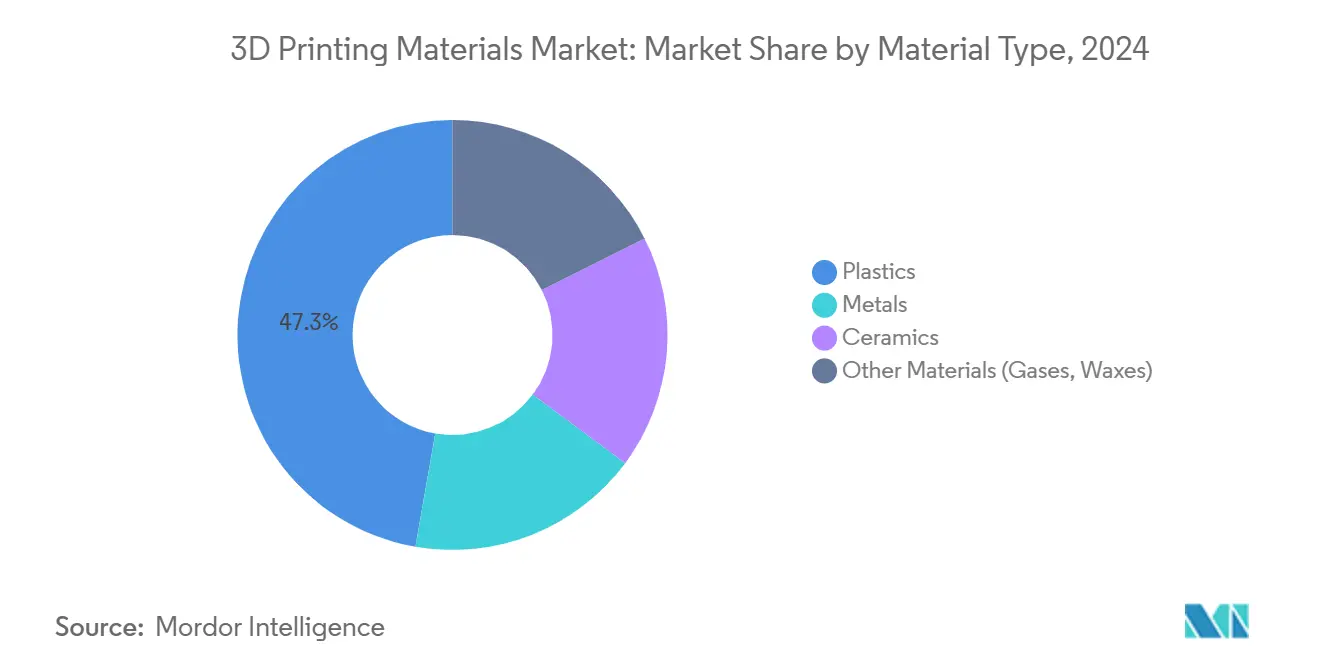
Note: Segment shares of all individual segments available upon report purchase
By Form: Filament Dominance Reflects Desktop Market Expansion
Filament captured 68.42% revenue share of the 3D printing materials market in 2024 and is forecast to grow at 23.51% CAGR on the back of hobbyist, education, and engineering-office adoption. Drop-in spool economics and the ubiquity of fused-filament fabrication drive frequent repeat purchases. The powder form remains indispensable for metal and polymer laser sintering applications where narrow particle-size distributions guarantee surface finish and mechanical integrity.
The liquid/resin segment supports stereolithography and digital light-processing platforms targeting dental models, microfluidic chips, and investment casting patterns. Photo-curable recipes with low residual monomer and improved UV stability promoted sizeable uptake in 2025, especially for chairside dental workflows. Although resin sales trail filament and powder volumes, a higher price per kilogram sustains a healthy revenue contribution to the overall 3D printing materials market size. Continuous innovation in low-odor, bio-derived photopolymers is expected to narrow the performance gap with engineering thermoplastics over the forecast horizon.
By End-user Industry: Automotive Overtakes Aerospace in Growth
Aerospace and defense commanded a 36.28% share of the 3D printing materials market in 2024 as OEMs and Tier-1 suppliers validated powdered metals for airframe brackets, ducting, and lightweight cabin interiors. Formal qualification programs underpin consistent repeat volumes and high margins for powder producers. The segment’s entrenched standards shield incumbents from commoditization pressures often felt in lower-spec polymer markets.
The automotive segment is poised for the fastest 24.87% CAGR through 2030, overtaking historical aerospace momentum as electrification and personalized interiors proliferate. Mass-produced EVs benefit from consolidated cooling plates, battery housings, and wire harness supports printed in high-strength polymers or aluminum. Early tooling successes expanded credibility for end-use parts, unlocking larger bill-of-materials opportunities. Consumer electronics and energy machinery provide additional corridors for future revenue as material performance envelopes broaden across the 3D printing materials market.
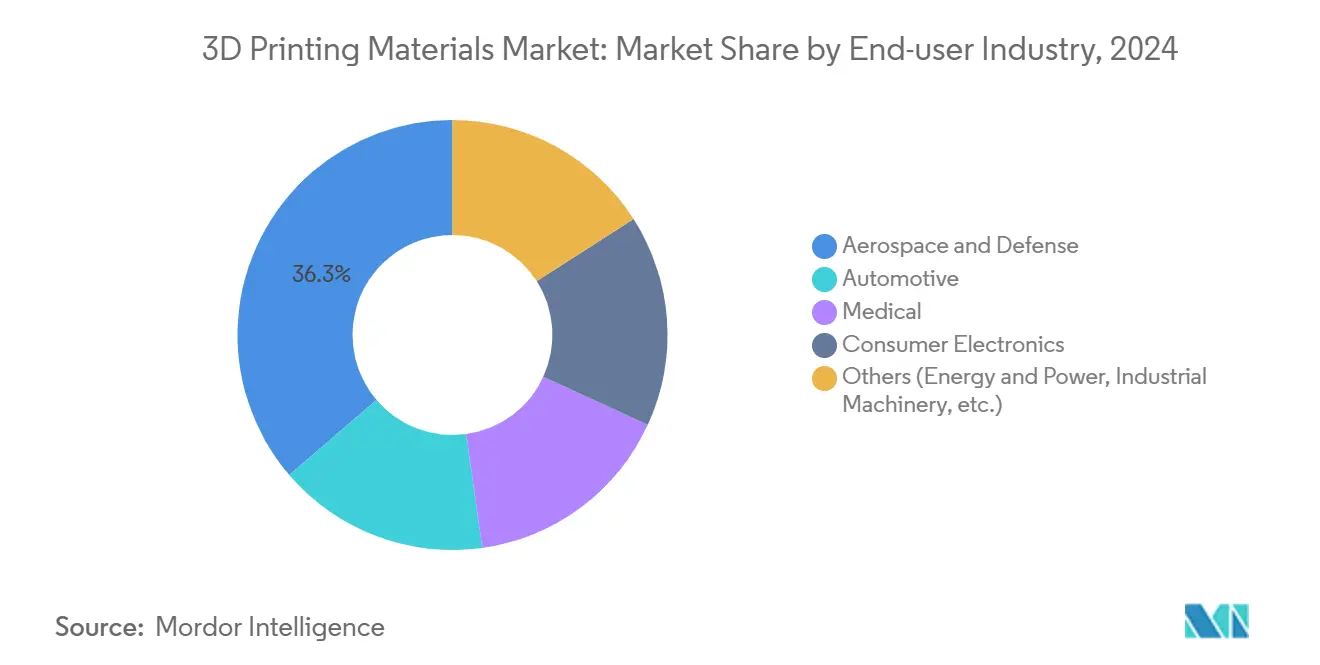
Note: Segment shares of all individual segments available upon report purchase
Geography Analysis
North America maintained leadership with 39.46% of the 3D printing materials market in 2024, supported by a robust aerospace supply chain, surgeon-led implant innovation, and federal funding channels such as the America Makes consortium. Material vendors leverage proximity to Tier-1 airframers and medical device clusters to co-develop application-specific powders and polymers. The region also hosts several powder recyclers that capture metal swarf and convert it into qualified additive feedstock, reducing dependence on virgin imports.
Asia-Pacific delivered the highest 26.25% CAGR and is projected to remain the growth engine through 2030. China dominates entry-level printer exports, providing cost advantages for bio-based polymers. Europe balances strong research and development capability with some of the strictest environmental regulations worldwide. The EU’s circular-economy directives encourage recycled feedstock adoption, positioning bio-derived PLA and PA11 for accelerated volume gains.
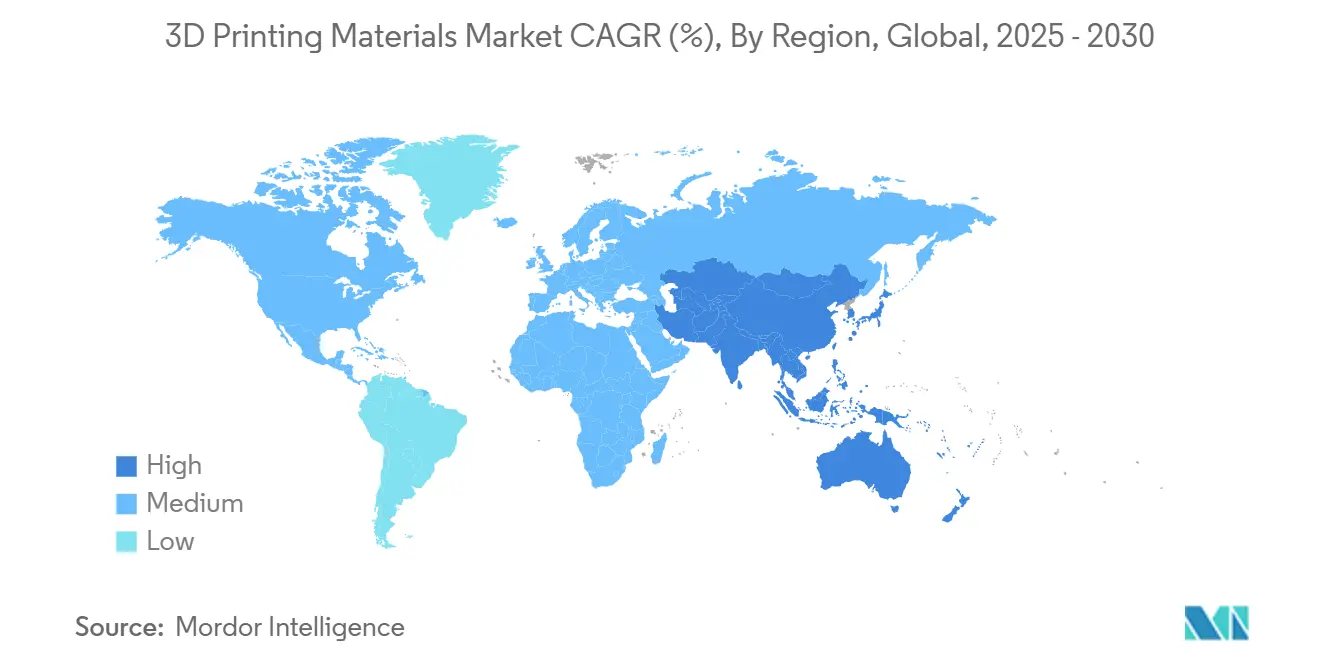
Competitive Landscape
The 3D printing materials market shows moderate fragmentation. Chemical majors such as BASF, Evonik, and Arkema leverage extensive polymer portfolios and global logistics networks to secure multiyear supply contracts with printer OEMs. Equipment vendors like Stratasys and 3D Systems pursue vertical integration, bundling proprietary powders and filaments with process-parameter databases to lock in recurring consumable sales.
3D Printing Materials Industry Leaders
-
3D Systems, Inc.
-
EOS GmbH
-
Stratasys
-
General Electric Company
-
Materialise
- *Disclaimer: Major Players sorted in no particular order

Recent Industry Developments
- April 2025: HP Development Company, L.P. announced commercial availability of HP 3D HR PA 12 FR, a halogen-free, flame-retardant polymer powder for 3D printing developed with Evonik for Multi Jet Fusion systems.
- February 2024: Evonik Industries AG launched a new photopolymer resin, INFINAM FR 4100L, that is flame retardant and mechanically durable when cured, designed for use with DLP 3D printers.
Research Methodology Framework and Report Scope
Market Definitions and Key Coverage
Our study defines the 3D printing materials market as the annual value of virgin polymers, metals, ceramics, and emerging composite or bio-based feedstocks that are purpose-manufactured for additive manufacturing equipment across all technologies (FDM/FFF, SLS, DMLS, SLA, binder jetting, and others). Materials consumed in post-processing or sold as refurbished lots are outside the scope.
Scope Exclusion: Second-hand powders, recycled spools, and in-house experimental batches are not counted.
Segmentation Overview
- By Material Type
- Plastics
- Acrylonitrile Butadiene Styrene (ABS)
- Polylactic Acid (PLA)
- Nylon
- Polyamide
- Polycarbonate
- Other Plastics (Composites, Biodegradable Polymers, etc.)
- Metals
- Ceramics
- Other Materials (Gases, Waxes)
- Plastics
- By Form
- Powder
- Filament
- Liquid/Resin
- By End-user Industry
- Aerospace and Defense
- Automotive
- Medical
- Consumer Electronics
- Others (Energy and Power, Industrial Machinery, etc.)
- By Geography
- Asia-Pacific
- China
- Japan
- South Korea
- India
- Singapore
- Rest of Asia-Pacific
- North America
- United States
- Canada
- Mexico
- Europe
- Germany
- United Kingdom
- France
- Italy
- Russia
- Rest of Europe
- South America
- Brazil
- Argentina
- Rest of South America
- Middle-East and Africa
- Saudi Arabia
- South Africa
- Rest of Middle-East and Africa
- Asia-Pacific
Detailed Research Methodology and Data Validation
Primary Research
Mordor analysts interviewed filament compounders, metal powder atomizers, aerospace materials engineers, and AM service bureaus across North America, Europe, and Asia-Pacific. Discussions clarified average selling prices, qualification lead times, and scrap-to-print ratios, then validated volume shares that secondary data hinted at but did not quantify.
Desk Research
We first mapped the demand pool through publicly available trade datasets such as UN Comtrade HS 391690 and 810890 for plastic powders and specialty metal alloys, national statistics from the US Census Bureau, Eurostat Comext, and China Customs, followed by regulatory references like ASTM F2792 and ISO/ASTM 52900 that clarify material categories. Industry white papers from the Additive Manufacturing Users Group, newsletters of the Society of Manufacturing Engineers, patent abstracts accessed via Questel, and company disclosures gathered on D&B Hoovers supplied production capacity, pricing swings, and technology adoption timelines. Additional context came from peer-reviewed journals in Additive Manufacturing and periodic releases of the International Organization for Standardization. The sources named are illustrative; analysts accessed many other documents to round out intelligence.
Market-Sizing & Forecasting
A top-down reconstruction began with import-export tonnage and domestic output of certified powders and filaments, converted to value through region-specific ASP curves. Results were pressure-tested with selective bottom-up checks that rolled up material revenues of fifteen leading suppliers and benchmarked them against installed printer counts in medical, automotive, and consumer segments. Key variables like printer shipment growth, aerospace metal uptake rates, polymer price indices, regulatory approvals, and powder reuse factors feed a multivariate regression that projects demand to 2030, with scenario analysis adjusting for feedstock price shocks. Where supplier disclosures lacked granularity, gap assumptions were moderated using median ratios from confirmed peers.
Data Validation & Update Cycle
We triangulate every iteration against shipment manifests, quarterly earnings, and price trackers. An anomaly log prompts re-contact with experts, and a senior analyst reviews the file before sign-off. Reports refresh yearly, while material events (for example, a nickel super-alloy shortage) trigger interim updates.
Why Mordor's 3D Printing Materials Baseline Is Dependable
Published figures often diverge because firms pick different feedstock lists, bundle services, or freeze exchange rates at varied points in time. Our disciplined scoping, live price tracking, and annual refresh cadence narrow those gaps.
Key gap drivers include whether spent powders are included, if hardware service revenue is mixed with material sales, and the aggressiveness of printer penetration assumptions; some publishers also extrapolate from isolated supplier data without cross-checking import flows.
Benchmark comparison
| Market Size | Anonymized source | Primary gap driver |
|---|---|---|
| USD 2.99 B (2025) | Mordor Intelligence | - |
| USD 3.58 B (2025) | Regional Consultancy A | Bundles prototype services with material revenue, limited trade-flow audit |
| USD 3.88 B (2025) | Global Consultancy B | Counts recycled feedstock and uses static 2024 ASPs |
In sum, our model balances real shipment evidence with supplier insights, giving decision-makers a transparent, reproducible baseline that stays current as the additive ecosystem evolves.
Key Questions Answered in the Report
What is the current size of the 3D printing materials market?
The 3D printing materials market is valued at USD 2.99 billion in 2025 and is projected to reach USD 8.10 billion by 2030.
Which material type is growing fastest in the 3D printing materials market?
Metal powders are expanding at a 23.24% CAGR through 2030, outpacing polymers and ceramics.
Why is Asia-Pacific considered the fastest-growing region?
Government incentives, large PLA production capacity and expanding aerospace partnerships are pushing Asia-Pacific toward a 26.25% CAGR.
What major restraint could slow market adoption?
High capital expense for industrial printers and volatile feedstock pricing currently subtract an estimated 3.7% from potential CAGR.
How are companies addressing sustainability in 3D printing materials?
Suppliers introduce bio-based polymers, recycled powders and closed-loop powder handling to cut waste and comply with EU circular-economy regulations.
Page last updated on:
